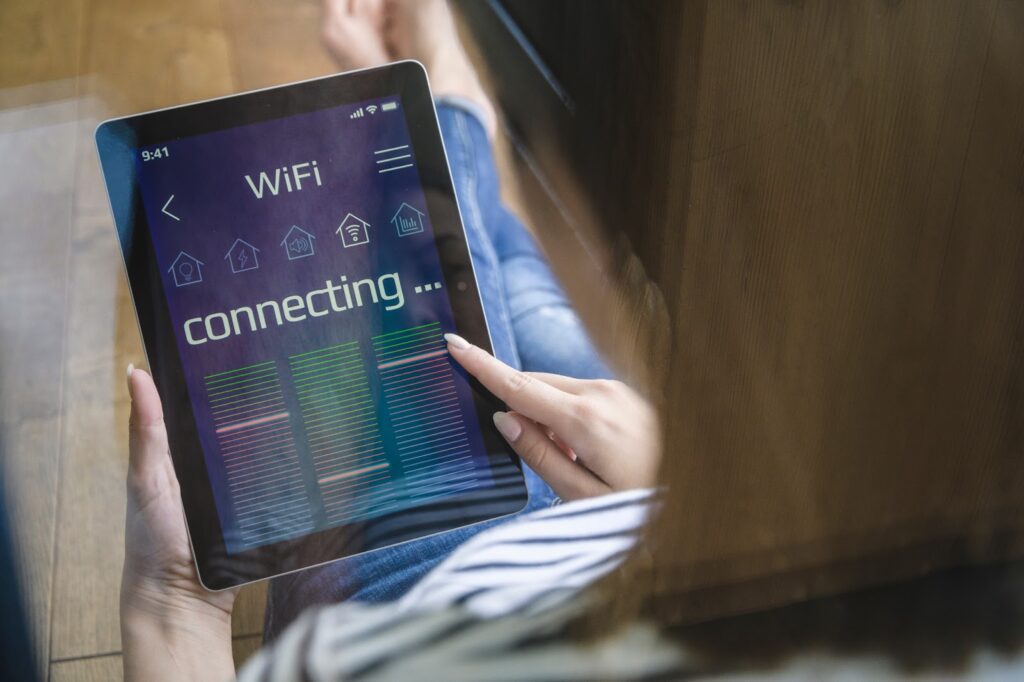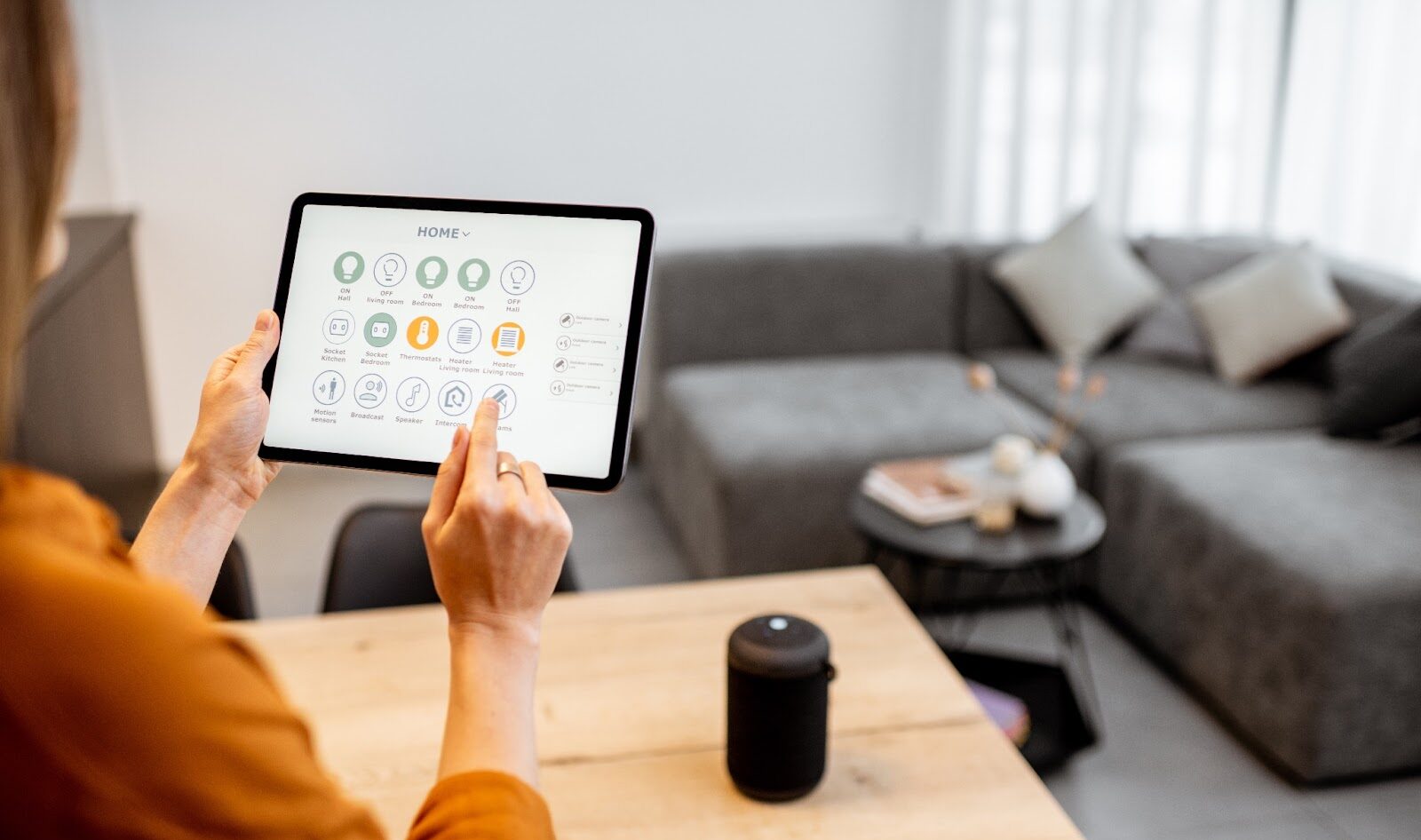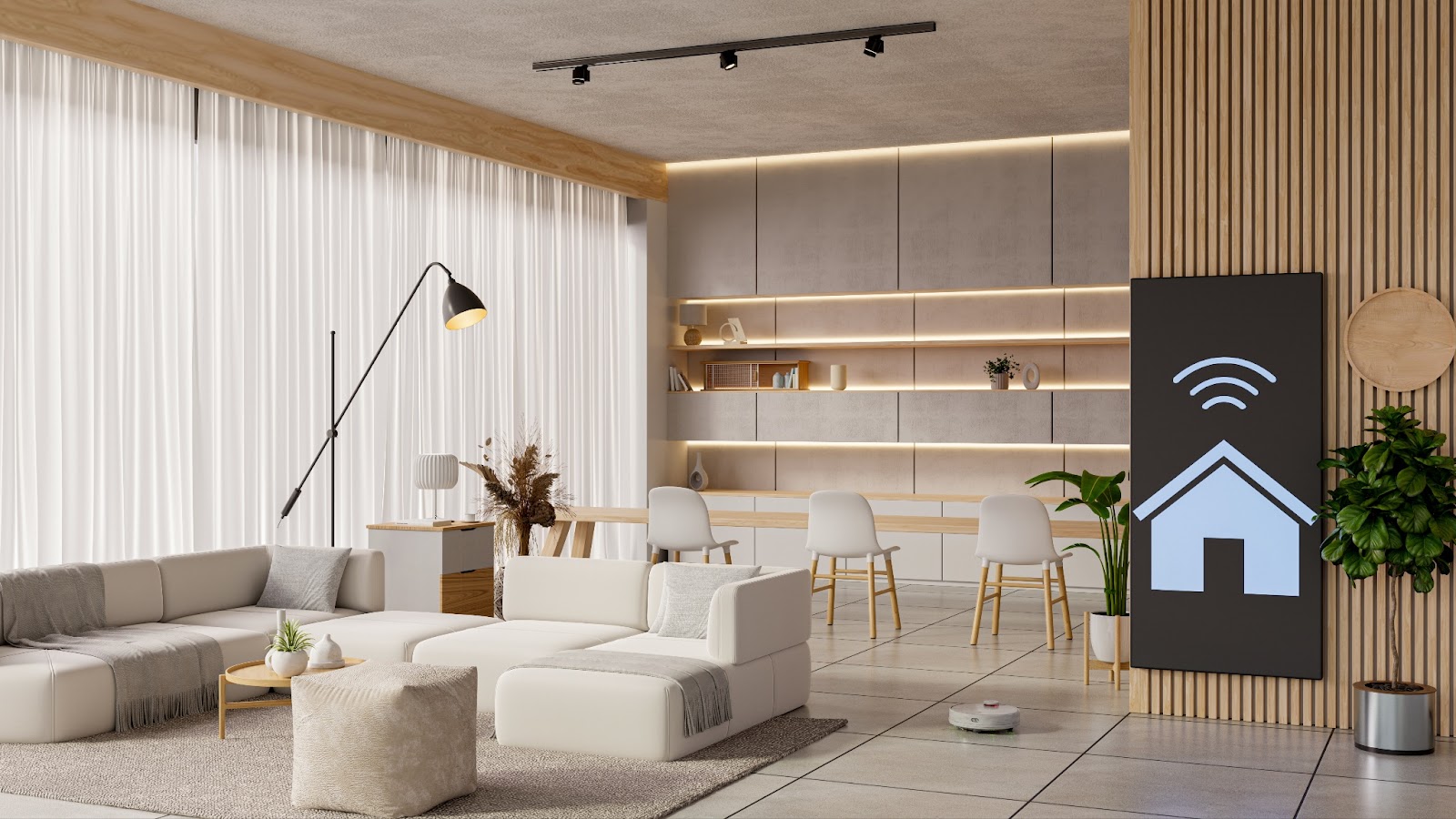
(Image Source: elements.envato.com)
What Is a Smart Home?
A smart home is a home that’s equipped with smart home systems. This includes smart curtains, smart home lighting, smart gadgets and more. These applications are connected to the internet, allowing you to control them via remote, smartphone or voice command.
The popularity of smart home setups are growing rapidly in Singapore. This is due to the growing desire for convenience, energy efficiency and enhanced security in urban areas.
With high-speed internet widely available, adopting smart home technology has become easier than ever.
How to Setup Your Smart Home

(Image Source: elements.envato.com)
Step 1: Determine Your Needs
Determine your wants and needs before purchasing any smart home devices. Check out other smart homes to get a better idea of how they work. Visit family and friends who have a smart home or check out our portfolio to find out more.
The idea is to figure out what smart home features are important to you. Do you want to control lighting and curtains remotely? Do you want to enhance security? Do you want to play music on command?
These are questions that can help you identify your priorities and needs.
Step 2: Choose & Buy Your Smart Home Devices
You can choose your smart home devices once you’ve determined your needs. Here are devices you might consider for your smart home:
Smart Lighting
Lights can be controlled remotely. It also comes with customisable changes, colour changes and scheduling through app or voice command.
Recommendations:
Smart Curtains & Blinds
Automate your window with smart curtains and blinds. Scheduled to open and close them at specific times or adjust them based on the amount of sunlight.
Recommendations:
Smart Kitchen
Transform your cooking space with our smart kitchen solutions. Turn your cooking routine into a seamless experience with appliances that can help you save time and energy.
Recommendations:
Smart Switches / Gadgets
Enhance your smart home experience with switches and gadgets. Pair them with other smart home technology to create a comprehensive smart home.
Recommendations:
Smart Home Appliances
Integrate our smart home appliances into your daily living. This includes digital locks, smart fans, presence sensors and more.
Recommendations:
Smart Home Systems or Smart Home Hub
The term “smart home system” and “smart home hub” are used interchangeably. Nonetheless, they actually refer to different components of a smart home setup. A smart home system is a group of smart devices that are connected to a single app.
This will allow you to control all your devices through apps like Google Home. A smart home hub is a group of smart devices that are connected to a special device. This will allow you to control all your devices by app, remote or both.
A hub is also more complex than a system. Users can integrate various communication protocols while enabling advanced automation routines.
For example, you can simultaneously turn on lights, close curtains and play music at a specific time of the day – like after coming home from work. A system however, has a straightforward setup that allows you to have centralised control.
At the end of the day, making the right choice comes down to specific needs:
Option 1: Voice Control or Touch Control Only
From fiction to reality, voice control and touch control are no longer the stuff of sci-fi. We highly recommend using voice control or touch control if you only have a few devices.
This will make it easier to manage your setup without the need for more software or hardware.
Option 2: Use a Smart Home System
Consider using a smart home system for a more integrated approach. It’s a great middle ground if you have a moderate number of devices and want a centralised control point. It’s also way easier to manage compared to a hub.
Option 3: Use a Smart Home System With a Built-in Hub
A system with a built-in hub has more advanced features and extensive controls. It combines the ease of a smart home system with the advanced capabilities of a hub.
This will give you the freedom to customise your smart home with greater flexibility. This option is recommended for larger homes with many devices.
Option 4: Use a Smart Home Hub
A smart home hub is ideal if you have a wide range of devices from different brands. A hub serves as the brain of your smart home, connecting various devices together.
You can make them work together seamlessly, creating an ecosystem of interconnected devices.
Step 3: Download & Install Smart Home Apps
You can’t have a smart home without the right app. Smart home apps allow you to control and manage your devices. Whether you’re using Google Home or Amazon Alexa, it’s important to use the right app according to your setup.
That’s where our Google Home Integration Service comes in. We’ll help you configure your Google Home or Amazon Alexa device to ensure proper connectivity. We’ll assess the compatibility of your existing devices and provide recommendations if needed.
We even offer hands-on training through our In-Person Smart Home App Tutorial Service! Check out our Smart Home Services to find out more.
Step 4: Set Up Your Smart Home Automation
You’ve installed your apps and now it’s time to set up your smart home automation. This is where some smart home innovation comes into play. The process involves creating routines and triggers that automate everyday tasks.
Here’s how you can get started:
Create Routines: Use your app to set up routines that trigger multiple actions at once. For example, you can create a “Good Morning” routine that turns on the lights, starts the coffee maker, and plays your favourite podcast.
Set Up Triggers: Triggers can be based on time, location, or specific actions. For instance, you can set your lights to turn on automatically when you arrive home.
Experiment with Different Automations: Try different automation setups to find the ones that best suit your lifestyle. You can adjust them as needed to optimise your comfort and convenience.
Utilise Voice Commands: Enhance your automation by integrating voice commands. This allows you to control multiple devices hands-free.
Your automations are as creative as you want them to be. Feel free to test various scenarios and don’t be afraid to push the limits!
Step 5: Test Your Smart Home
With all that out of the way, you can finally test your smart home. Here are 4 things to keep in mind:
- Remember to test each device individually.
- Test your automations and make sure they work in tandem with each other.
- Test your voice commands and make sure they respond promptly.
- Test your remote access to ensure you can control your devices remotely.
If any issues arise, refer to your app’s troubleshooting guide or contact us for assistance.
How to Optimize Wi-Fi Speed for your Smart Home

(Image Source: elements.envato.com)
Wi-fi is everything in this day and age. Having better internet connectivity will not only boost your viewing experience but also your smart home setup. Conversely, a bad wifi connection can be a major red flag when it comes to smart homes.
You wouldn’t want your lights to flicker uncontrollably or your security cameras to malfunction in the middle of the night! That’s why it’s important to optimise your wi-fi speed the best you can. Here’s what you need to do:
This includes encrypting your internet connection with a VPN or using a strong password.
Reduce Interference From Other Devices: Disconnect devices that aren’t being used. This will free up bandwidth for your smart home devices.
Utilise Mesh Networking: If your home is large or has multiple floors, a mesh network can help extend the Wi-Fi coverage without losing speed.
Mesh networks provide multiple access points that work together to ensure a strong signal in every corner of your home.
Conclusion
Once a smart home owner, always a smart home owner. Your first set up will be a testament to more upgrades to come – trust us, we’ve been there! Just remember to follow this guide and your smart home will definitely be a “smart” decision to begin with.
Visit AT Smart Home for all your smart home inquiries and needs!





